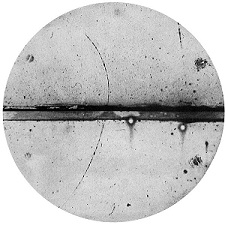How true is the matter antimatter version of the Universe? The theory arose mainly out of theoretical considerations. According to this theory matter and antimatter particles are always produced as a pair and, if they come in contact, annihilate one another, leaving behind pure energy. The modern theory of antimatter began in 1928, with a paper by Paul Dirac. Dirac realised that his relativistic version of the Schrödinger wave equation for electrons predicted the possibility of antielectrons. In fact Dirac calculated that Einstein's relativity implied that every particle in the universe has a corresponding antiparticle, each with the same mass as its twin, but with the opposite electrical charge. What if the Schrodinger wave theory is wrong, won’t it then follow that the whole of the matter anti-matter Universe is also wrong? What if special relativity is also wrong? Do positrons exist? The whole of the existence of the positron was based on the cloud chamber experiment conducted by Carl Anderson in the 1930’s. According to his claim a positron was detected in the cloud chamber. Anderson surrounded his cloud chamber with a large electromagnet, which caused the paths of ionizing particles to bend into circular paths. By measuring the curvature of those tracks, he could calculate the particles' momentum and determine the sign of
the charge. In the normal course of things an electron can never be attracted towards the negative pole of a magnet, it will always be diverted towards the positive pole in a magnetic field.

The positron entered the cloud chamber in the lower left, was slowed down by the lead plate, and curved to the upper left. The curvature of the path is caused by an applied magnetic field that acts perpendicular to the image plane. The higher energy of the entering positron resulted in lower curvature of its path.
By measuring the curve, momentum and speed of the particle, Anderson was able to conclude that the particle was not a proton. The length of the path was at ;least ten times greater than would be left by a proton which has a mass 1862 times that of the electron. The curve of the track and its length corresponded almost exactly with the track that would be left by an electron but going to the negative instead of the positive pole. Hence a positron! This claim that the particle was a positron has never been contested. Yet if one looks closely at the experiment one finds that it is almost and exact analogue of the experiment to determine the Lorentz force. Here you have a magnetic field set up perpendicular to the plane of the experiment. You have a charged particle moving at velocity. It should be noted that in the experiment for the Lorentz force, the charge of the particle does not matter, it doesn’t matter if it is a proton involved or an electron, all that matters is the velocity of the particle. The particle can then move to either pole, the positive or the negative! The conclusion is that the electron was impartially drawn towards the negative pole by the Lorentz force.

The conclusion is that what was discvered was not the positron but a new example of the Lorentz force.
As far as PET goes (positron emission tomography) goes, it would work equally well with any radio active material that emits photons on annihilation. Nothing to stipulate that those photons must be from a positron electron annihilation.
Just a thought.
the charge. In the normal course of things an electron can never be attracted towards the negative pole of a magnet, it will always be diverted towards the positive pole in a magnetic field.

The positron entered the cloud chamber in the lower left, was slowed down by the lead plate, and curved to the upper left. The curvature of the path is caused by an applied magnetic field that acts perpendicular to the image plane. The higher energy of the entering positron resulted in lower curvature of its path.
By measuring the curve, momentum and speed of the particle, Anderson was able to conclude that the particle was not a proton. The length of the path was at ;least ten times greater than would be left by a proton which has a mass 1862 times that of the electron. The curve of the track and its length corresponded almost exactly with the track that would be left by an electron but going to the negative instead of the positive pole. Hence a positron! This claim that the particle was a positron has never been contested. Yet if one looks closely at the experiment one finds that it is almost and exact analogue of the experiment to determine the Lorentz force. Here you have a magnetic field set up perpendicular to the plane of the experiment. You have a charged particle moving at velocity. It should be noted that in the experiment for the Lorentz force, the charge of the particle does not matter, it doesn’t matter if it is a proton involved or an electron, all that matters is the velocity of the particle. The particle can then move to either pole, the positive or the negative! The conclusion is that the electron was impartially drawn towards the negative pole by the Lorentz force.

The conclusion is that what was discvered was not the positron but a new example of the Lorentz force.
As far as PET goes (positron emission tomography) goes, it would work equally well with any radio active material that emits photons on annihilation. Nothing to stipulate that those photons must be from a positron electron annihilation.
Just a thought.



